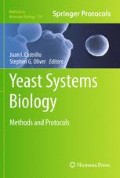Abstract
The automated cell, compound and environment screening system (ACCESS) was developed as an automated platform for chemogenomic research. In the yeast Saccharomyces cerevisiae, a number of genomic screens rely on the modulation of gene dose to determine the mode of action of bioactive compounds or the effects of environmental/compound perturbations. These and other phenotypic experiments have been shown to benefit from high-resolution growth curves and a highly automated controlled environment system that enables a wide range of multi-well assays that can be run over many days without any manual intervention. Furthermore, precise control of drug dosing, timing of drug exposure, and precise timing of cell harvesting at specific generation times are important for optimal results. Some of these benefits include the ability to derive fine distinctions between growth rates of mutant strains (1) and the discovery of novel compounds and drug targets (2). The automation has also enabled large-scale screening projects with over 100,000 unique compounds screened to date including a thousand genome-wide screens (3). The ACCESS system also has a diverse set of software tools to enable users to set up, run, annotate, and evaluate complex screens with minimal training.
M. Proctor and M.L. Urbanus contributed equally to this work.
Supporting web site: http://chemogenomics.med.utoronto.ca/supplemental/ACCESS/
Supporting web site: http://chemogenomics.med.utoronto.ca/supplemental/ACCESS/
Access this chapter
Tax calculation will be finalised at checkout
Purchases are for personal use only
References
Deutschbauer, A. M., Jaramillo, D. F., Proctor, M., et al. (2005) Mechanisms of haploinsufficiency revealed by genome-wide profiling in yeast. Genetics 169, 1915–1925.
Hoon, S., Smith, A. M., Wallace, I. M., et al. (2008) An integrated platform of genomic assays reveals small-molecule bioactivities. Nat. Chem. Biol. 4, 498–506.
Hillenmeyer, M. E., Fung, E., Wildenhain, J., et al. (2008) The chemical genomic portrait of yeast: uncovering a phenotype for all genes. Science 320, 362–365.
Giaever, G., Shoemaker, D. D., Jones, T. W., et al. (1999) Genomic profiling of drug sensitivities via induced haploinsufficiency. Nat. Genet. 21, 278–283.
Winzeler, E. A., Shoemaker, D. D., Astromoff, A., et al. (1999) Functional characterization of the S. cerevisiae genome by gene deletion and parallel analysis. Science 285, 901–906.
Giaever, G., Chu, A. M., Ni, L., et al. (2002) Functional profiling of the Saccharomyces cerevisiae genome. Nature 418, 387–391.
Pierce, S. E., Fung, E. L., Jaramillo, D. F., et al. (2006) A unique and universal molecular barcode array. Nat. Methods 3, 601–603.
Pierce, S. E., Davis, R. W., Nislow, C., and Giaever, G. (2007) Genome-wide analysis of barcoded Saccharomyces cerevisiae gene-deletion mutants in pooled cultures. Nat. Protoc. 2, 2958–2974.
Giaever, G., Flaherty, P., Kumm, J., et al. (2004) Chemogenomic profiling: identifying the functional interactions of small molecules in yeast. Proc. Natl. Acad. Sci. USA 101, 793–798.
Lee, W., St. Onge, R. P., Proctor, M., et al. (2005) Genome-wide requirements for resistance to functionally distinct DNA-damaging agents. PLoS Genet. 1, e24.
St. Onge, R. P., Mani, R., Oh, J., et al. (2007) Systematic pathway analysis using high-resolution fitness profiling of combinatorial gene deletions. Nat. Genet. 39, 199–206.
Ericson, E., Gebbia, M., Heisler, L. E., et al. (2008) Off-target effects of psychoactive drugs revealed by genome-wide assays in yeast. PLoS Genet. 4, e1000151.
Yan, Z., Costanzo, M., Heisler, L. E., et al. (2008) Yeast Barcoders: a chemogenomic application of a universal donor-strain collection carrying bar-code identifiers. Nat. Methods 5, 719–725.
Spector, M. S., Raff, A., DeSilva, H., Lee, K., and Osley, M. A. (1997) Hir1p and Hir2p function as transcriptional corepressors to regulate histone gene transcription in the Saccharomyces cerevisiae cell cycle. Mol. Cell. Biol. 17, 545–552.
Sutton, A., Bucaria, J., Osley, M. A., and Sternglanz, R. (2001) Yeast ASF1 protein is required for cell cycle regulation of histone gene transcription. Genetics 158, 587–596.
Simon, I., Barnett, J., Hannett, N., et al. (2001) Serial regulation of transcriptional regulators in the yeast cell cycle. Cell 106, 697–708.
Gasch, A. P., Spellman, P. T., Kao, C. M., et al. (2000) Genomic expression programs in the response of yeast cells to environmental changes. Mol. Biol. Cell 11, 4241–4257.
Sheff, M. A., and Thorn, K. S. (2004) Optimized cassettes for fluorescent protein tagging in Saccharomyces cerevisiae. Yeast 21, 661–670.
Acknowledgments
The authors would like to thank Bob St. Onge (Stanford HIPHOP lab) for suggestions for the continued development of the ACCESS robots; Larry Heisler (Toronto HIPHOP lab) for development of the Infinite conversion scripts and web site tools; Pinay Kainth from the University of Toronto for the generous gift of the HT1A-GFP strains; Mark Torresan (Tecan USA) for many years of helpful advice and support; and Susan Dutcher (Washington University School of Medicine) for C. reinhardtii strains and advice. Finally, we would like to thank all past and present members of the Stanford and Toronto HIPHOP laboratories for their feedback, support, and innovative use of the ACCESS robots. This work was supported by grants from NIH (NCI, NBIB, and NHGRI) and CIHR to R.W.D., C.N., and G.G, and from the Canadian Cancer Society (020380) to G.G.
Author information
Authors and Affiliations
Corresponding author
Editor information
Editors and Affiliations
Rights and permissions
Copyright information
© 2011 Humana Press
About this protocol
Cite this protocol
Proctor, M. et al. (2011). The Automated Cell: Compound and Environment Screening System (ACCESS) for Chemogenomic Screening. In: Castrillo, J., Oliver, S. (eds) Yeast Systems Biology. Methods in Molecular Biology, vol 759. Humana Press. https://doi.org/10.1007/978-1-61779-173-4_15
Download citation
DOI: https://doi.org/10.1007/978-1-61779-173-4_15
Published:
Publisher Name: Humana Press
Print ISBN: 978-1-61779-172-7
Online ISBN: 978-1-61779-173-4
eBook Packages: Springer Protocols

